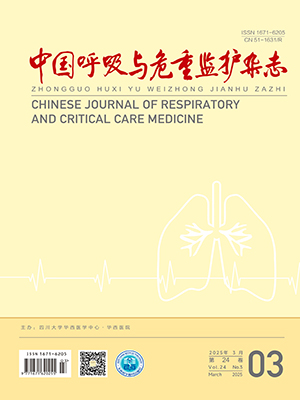| 1. |
Negewo NA, McDonald VM, Baines KJ, et al. Peripheral blood eosinophils:a surrogate marker for airway eosinophilia in stable COPD. Int J Chron Obstruct Pulmon Dis, 2016, 11:1495-1504.
|
| 2. |
Zanini A, Cherubino F, Zampogna E, et al. Bronchial hyperresponsiveness, airway inflammation, and reversibility in patients with chronic obstructive pulmonary disease. Int J Chron Obstruct Pulmon Dis, 2015, 10:1155-1161.
|
| 3. |
Brightling CE, Monteiro W, Ward R, et al. Sputum eosinophilia and short-term response to prednisolone in chronic obstructive pulmonary disease:a randomised controlled trial. Lancet, 2000, 356:1480-1485.
|
| 4. |
Brightling CE, Bleecker ER, Panettieri RA Jr, et al. Benralizumab for chronic obstructive pulmonary disease and sputum eosinophilia:a randomised, double-blind, placebo-controlled, phase 2a study. Lancet Respir Med, 2014, 2:891-901.
|
| 5. |
Barnes NC, Sharma R, Lettis S, et al. Blood eosinophils as a marker of response to inhaled corticosteroids in COPD. Eur Respir J, 2016, 47:1374-1382.
|
| 6. |
Kang HS, Rhee CK, Kim SK, et al. Comparison of the clinical characteristics and treatment outcomes of patients requiring hospital admission to treat eosinophilic and neutrophilic exacerbations of COPD. Int J Chron Obstruct Pulmon Dis, 2016, 11:2467-2473.
|
| 7. |
Bafadhel M, Greening NJ, Harvey-Dunstan TC, et al. Blood eosinophils and outcomes in severe hospitalized exacerbations of COPD. Chest, 2016, 150:320-328.
|
| 8. |
Eltboli O, Bafadhel M, Hollins F, et al. COPD exacerbation severity and frequency is associated with impaired macrophage efferocytosis of eosinophils. BMC Pulmon Med, 2014, 14:112-121.
|
| 9. |
Duman D, Aksoy E, Agca MC, et al. The utility of inflammatory markers to predict readmissions and mortality in COPD cases with or without eosinophilia. Int J Chron Obstruct Pulmon Dis, 2015, 10:2469-2478.
|
| 10. |
Hospers JJ, Schouten JP, Weiss ST, et al. Eosinophilia is associated with increased all-cause mortality after a follow-up of 30 years in a general population sample. Epidemiology, 2000, 11:261-268.
|
| 11. |
Siva R, Green RH, Brightling CE, et al. Eosinophilic airway inflammation and exacerbations of COPD:a randomized controlled trial. Eur Respir J, 2007, 29:906-913.
|
| 12. |
Soter S, Barta I, Antus B. Predicting sputum eosinophilia in exacerbations of COPD using exhaled nitric oxide. Inflammation, 2013, 36:1178-1185.
|
| 13. |
中华医学会呼吸病学分会慢性阻塞性肺疾病学组.慢性阻塞性肺疾病诊治指南(2013年修订版).中华结核和呼吸杂志, 2013, 36:255-264.
|
| 14. |
张伟兵, 王欣燕, 田晓彦, 等.ADAM33基因多态性影响慢性阻塞性肺疾病气道炎症.中国呼吸与危重监护杂志, 2012, 11:15-18.
|
| 15. |
郑劲平.关于制定我国用力肺功能检测质量控制指引的建议.中华结核和呼吸杂志, 2004, 27:716-717.
|
| 16. |
Celli BR, MacNee W, ATS/ERS Task Force. Standards for the diagnosis and treatment of patients with COPD:a summary of the ATS/ERS position paper. Eur Respir J, 2004, 23:932-946.
|
| 17. |
Djukanovi Ac'G R, Sterk PJ, Fahy JV, et al. Standardised methodology of sputum inductionf and processing. Eur Respir J Suppl, 2002, 37:1s-2s.
|
| 18. |
Perng DW, Huang HY, Chen HM, et al. Characteristics of airway inflammation and bronchodilator reversibility in COPD:a potential guide to treatment. Chest, 2004, 126:375-381.
|
| 19. |
罗炜, 赖克方, 钟南山.诱导痰检测的方法学及其在气道炎症评价中的应用.国外医学呼吸系统分册, 2004, 24:395-397.
|
| 20. |
Davidson WJ, Verity WS, Traves SL, et al. Effect of incremental exercise on airway and systemic inflammation in patients with COPD. J Appl Physiol, 2012, 112:2049-2056.
|
| 21. |
Liesker JJ, Bathoorn E, Postma DS, et al. Sputum inflammation predicts exacerbations after cessation of inhaled corticosteroids in COPD. Respir Med, 2011, 105:1853-1860.
|
| 22. |
Bafadhel M, McKenna S, Terry S, et al. Blood eosinophils to direct corticosteroid treatment of exacerbations of chronic obstructive pulmonary disease:a randomized placebo-controlled trial. Am J Respir Crit Care Med, 2012, 186:48-55.
|
| 23. |
Bafadhel M, McKenna S, Terry S, et al. Acute exacerbations of chronic obstructive pulmonary disease identification of biologic clusters and their biomarkers. Am J Respir Crit Care Med, 2011, 184:662-671.
|
| 24. |
Brightling CE, McKenna S, Hargadon B, et al. Sputum eosinophilia and the short term response to inhaled mometasone in chronic obstructive pulmonary disease. Thorax, 2005, 60:193-198.
|
| 25. |
Ernst P, Saad N, Suissa S. Inhaled corticosteroids in COPD:the clinical evidence. Eur Respir J, 2015, 45:525-37.
|
| 26. |
Vestbo J, Pauwels R, Anderson JA, et al. Early onset of effect of salmeterol and fluticasone propionate in chronic obstructive pulmonary disease. Thorax, 2005, 60:301-314.
|




